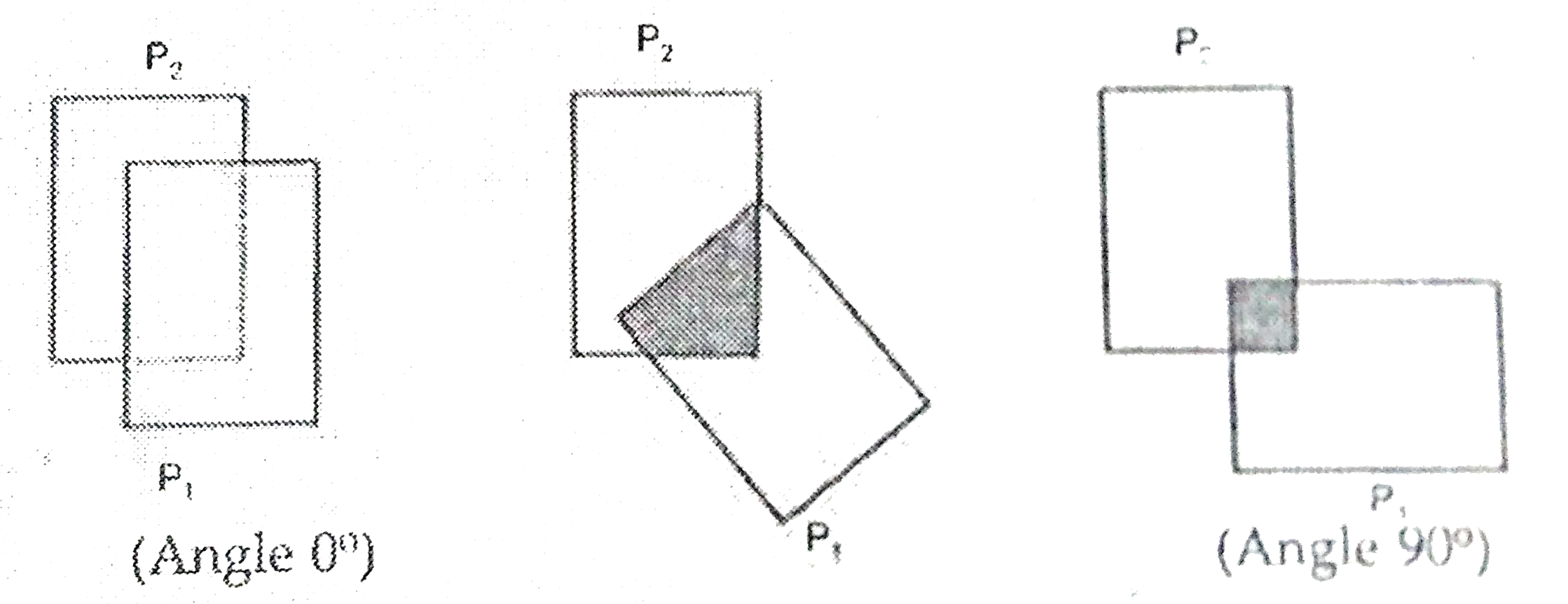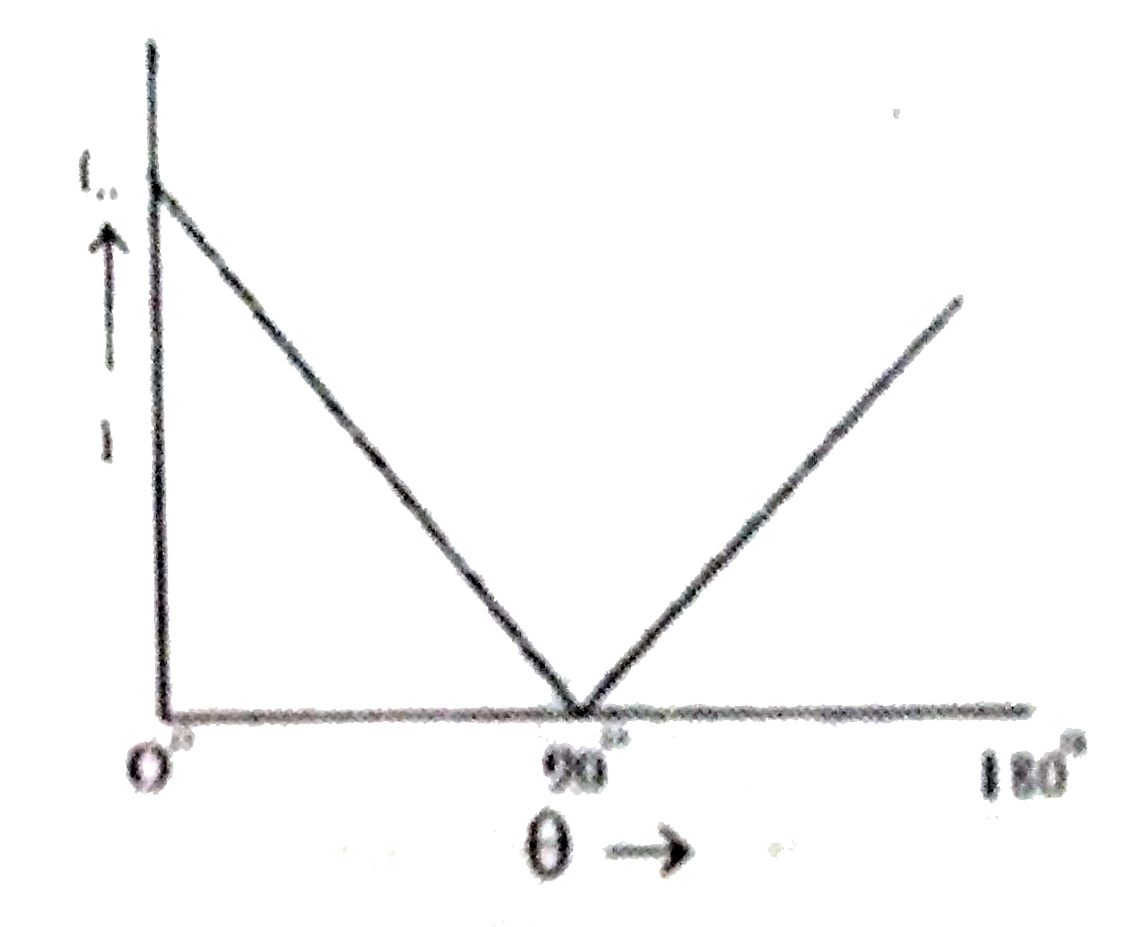How does an unpolarised light get polarised when passed through a polarised ?
Two polaroids are set in crossed positions . A third polaroid is placed between the two making an angle θ with the pass axis of the first polaroid . Write the expression for the intensity of light transmitted from the second polaroid . In what orientations will the transmitted intensity be (i) minimum and (ii) maximum ?
If an unpolarised light wave is incident on a polaroid then the light get linearly polarised with the electric vector oscillating along a direction perpendicular to the aligned molecules .
If the light from an ordinary source (like a sodium lamp) passes through a polaroid sheet P1, it is observed that its intensity is reduced by half.Rotating P1 has no effect on the transmitted beam and transmitted intensity constant .
Let an identical piece of polaroid P2 be placed before P1 , the light from the lamp is reduced in intensity on passing through P2 alone . But rotating P1 has effect on the light coming from P2.
In one position , the intensity transmitted by P2 followed by P1 is nearly zero . When turned by 90∘ from this position P1 transmits nearly the full intensity emerging from P2 as shown in fig.

Graph : The graph between intensity of light and the angle between polariser and analyser is shown in the figure .
When the polaroid is rotated in the path of plane polarised light , its intensity will vary from maximum (When the vibrations of the plane polarised light are parallel to the axis of the polaroid ) to minimum (When the direction of vibrations becomes perpendicular to the axis of the crystal).
Let I0 be the intensity of polarised light after passing through first polariser P1 . Then intensity of light after passing through second polariser P2 is given by I=I0cos2θ.

Topper's Solved these Questions
- XII BOARDSBOOK - XII BOARDS PREVIOUS YEARCHAPTER - XII BOARDSEXERCISE - SET -II
9 Videos
- XII BOARDSBOOK - XII BOARDS PREVIOUS YEARCHAPTER - XII BOARDSEXERCISE - SET -III
6 Videos
- XII BOARDSBOOK - XII BOARDS PREVIOUS YEARCHAPTER - XII BOARDSEXERCISE - SET-III DELHI BOARD
11 Videos
- SAMPLE PAPER 2019BOOK - XII BOARDS PREVIOUS YEARCHAPTER - SAMPLE PAPER 2019EXERCISE - SECTION D
6 Videos
Similar Questions
How does an unpolarised light get polarised when passed through a polaroid ?
Two polaroids are set in crossed positions . A third polaroid is placed between the two making an angle θ with the pass axis of the first polaroid . Write the expression for the intensity of light transmitted from the second polaroid . In what orientations will the transmitted intensity be (i) minimum and (ii) maximum ?
View SolutionHow does an unpolarised light get polarised when passed through a polaroid ?
Two polaroids are set in crossed position. A third polaroid is placed between the two making an angle θ with the pass axis of the first polaroid. Write the expression for the intensity of light transmitted from the second polaroid. in what orientations will the transmitted intensity be (i) minimum and (ii) maximum ?
View Solution
Knowledge Check
Two 'crossed' polaroids A and B are placed in the path of a light-beam. In between these, a third polaroid is C is placed whose polarisation axis makes an angle θ with a polarisation axis of the polaroid A. If the intensity of light emerging from the polaroid a is Io then show that the intensity of light emerging from polaroid B will be 14Iosin2θ.
AI04sin22ϕBI04sin2ϕCI04cos2ϕDI02cos22ϕTwo polaroids are placed in the path of unpolarised light of intensity I0 such that no light is emitted from the second polaroid. If a third polaroid, whose pass axis makes an angle θ with the pass axis of first polaroid, is placed between these polaroid then the intensity of the light emerging from the last polaroid will be
AI08sin22θBI04sin22θCI02cos4θDI0cos2θ
Two polaroid A and B are set in crossed positions. A third polaroid C is placed between the two making ∠θ with the pass axis of first polaroid. Write the expression for intensity of light transmitted from second polaroid. In what orientations will be transmitted intensity be (i) minimum (ii) maximum ?
View SolutionTwo polaroid A and B are set in crossed positions. A third polaroid C is placed between the two making ∠θ with the pass axis of first polaroid. Write the expression for intensity of light transmitted from second polaroid. In what orientations will be transmitted intensity be (i) minimum (ii) maximum ?
View SolutionFind an expression for intensity of transmitted light when a polaroid sheet is rotated between I polaroids. In which position of the polaroid sheet will the transmitted intensity be maximum ?
View SolutionUnpolarised light of intensity I is incidnet of the polaroid. What will be the intensity of light transmitted by the polaroid?
View SolutionTwo 'crossed' polaroids A and B are placed in the path of a light-beam. In between these, a third polaroid is C is placed whose polarisation axis makes an angle θ with a polarisation axis of the polaroid A. If the intensity of light emerging from the polaroid a is Io then the intensity of light emerging from polaroid B will be
View Solution(a) How does one demonstrate, using a suitable diagram, that unpolarised light when passed through a Polaroid gets polarised?
(b) A beam of unpolarised light is incident a glass-air interface. Show using a suitable ray diagram, that light reflected from the interface is totally polarised, when μ=taniB, when μ is the refractive index of glass with respect to air and iB, is the Brewster's angle.
View Solution
